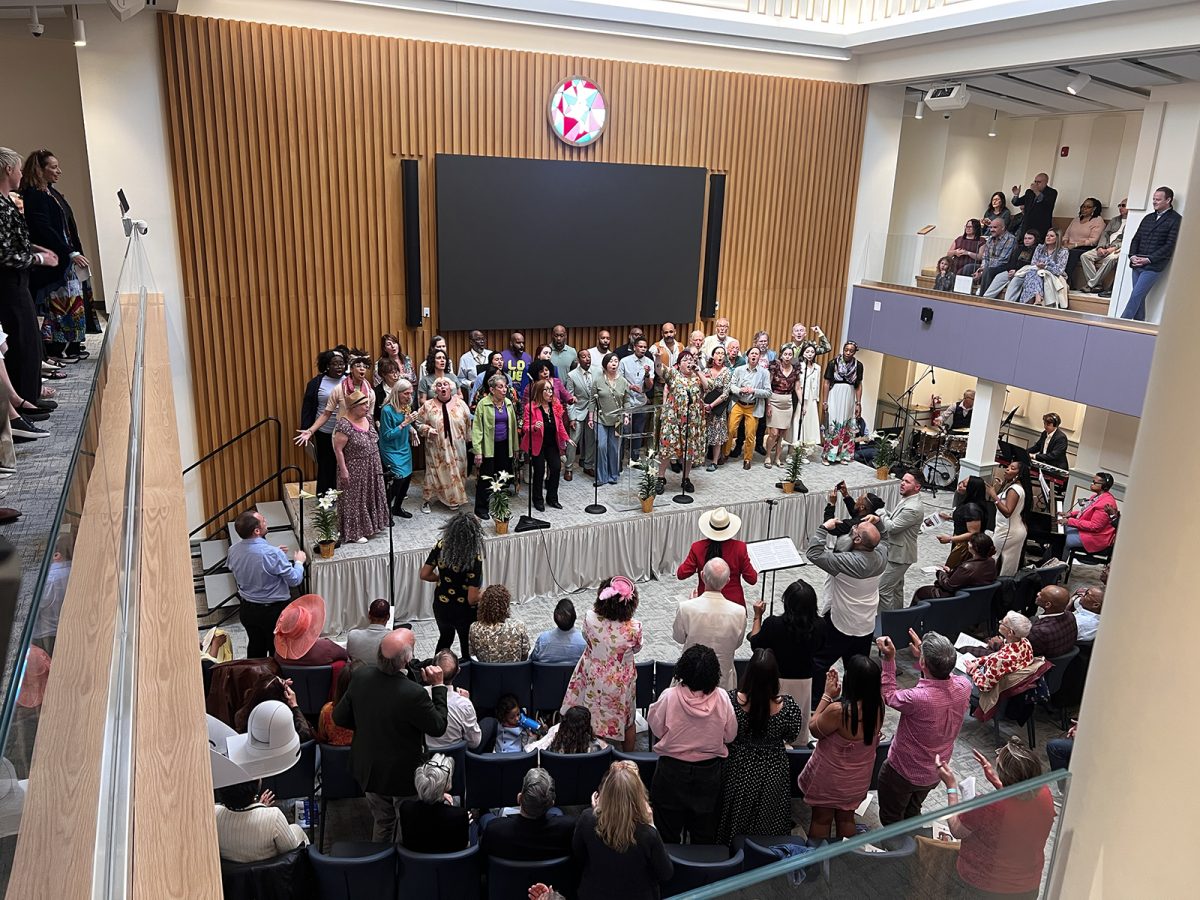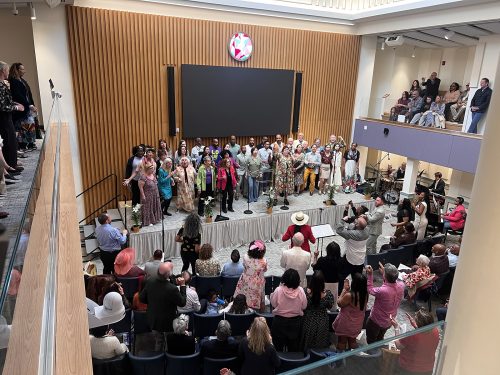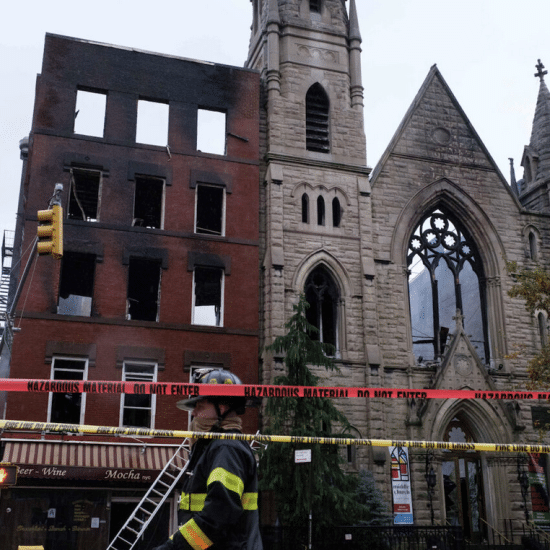
NEW YORK (RNS) — As she approached the pulpit on Easter Sunday (April 20), the Rev. Jacqueline J. Lewis, the senior minister of Middle Collegiate Church, couldn’t hold back her tears. It was the first time the congregation had gathered in a building it could call its own since a December 2020 fire destroyed the historic church’s 128-year-old home.
“I’m so glad you’re here, in this incredible moment, on this incredible historic day, when we come back home,” Lewis told the congregation dressed in their Easter finery.

The Middle Collegiate Church choir performs on Easter Sunday, the congregation’s first service at 50 E. Seventh Street, April 20, 2025, in New York. (Photo courtesy of Middle Collegiate Church)
The morning worship service, led by Middle’s choir, drew nearly 200 people who came to celebrate both Christ’s resurrection and Middle Collegiate’s rising from the ashes of the devastating fire, which not only left the congregation homeless but prompted churchwide soul searching about their future.
A few days before the reopening, Lewis, an author and nationally known anti-racism and economic equity activist, sat down with RNS to discuss the years since the fire and Middle’s plans.
The years of scrambling to preserve the church’s mission during renovations, the senior minister said, were trying, but affirmed for her the value of the community. “The larger project, to me, wasn’t raising the money. The larger project was to continue to raise hope and a sense of resilience and a sense of joy that we got this,” she said.
In the winter of 2020 and 2021, just as many other New York congregations were returning to in-person services after COVID-19 lockdowns, Middle had to remain online. But Lewis knew the group had a will to gather. “Being placeless was a challenge for our people. … You’re in the wilderness and you yearn for home,” she said. They tapped interfaith connections to find shared space at Calvary Church-St. George’s, an Episcopal church in the Gramercy Park neighborhood, and later East End Temple in the Lower East Side, and Judson Memorial Church in the West Village.

Firefighters work to extinguish a fire that erupted from the building next to Middle Collegiate Church on Dec. 5, 2020, in New York. The historic 19th-century church in lower Manhattan was gutted by a massive fire that sent flames shooting through the roof. (AP Photo/Yuki Iwamura)
Meanwhile, the church’s leadership worked to rebuild its sanctuary by incorporating what remained of the neo-Gothic facade of the 1892 church and its back wall, which had survived the fire, but barely. In the end, they were too damaged to be used, and after permission from New York City’s Landmarks Preservation Commission was secured, the decision was made to demolish the walls. In November 2023, congregants watched them go down from the same corner they’d watched the church burn down, adding “another layer of grief,” said Lewis.
The facade’s demolition, however, freed up funds that had been going to propping it up, giving the renovation a fresh start. As a new church was planned, the congregation shifted its worship to a social hall for the church whose front door was around the corner, at 50 E. Seventh St. Though it was severely damaged by water used to put out the fire, this annex building was whole enough to serve as a new sanctuary.
The worship space can welcome 225 people, about 100 fewer than the old church. Lewis, quoting a verse from the Bible’s Book of Isaiah — “I am doing a new thing: now it springs forth, do you not perceive it?” — said the community sees a biblical sign in this former social space being repurposed.

The Rev. Jacqueline J. Lewis speaks during the Middle Collegiate Church Easter service, April 20, 2025, in New York. (Photo courtesy of Middle Collegiate Church)
As the last parts of the former sanctuary vanished, the congregation, founded in 1628 by Reformed Dutch settlers, also turned to reinventing its identity, said Lewis. “Without the facade, we’re still us. Without the facade, there’s even a stronger future opportunity. We get to start from scratch on that lot, and see what it is that God is calling us to build,” she said.
The community is aiming to preserve its social justice work in its Lower East Side neighborhood. In the 1980s, it welcomed members of the LGBTQ+ community during the AIDS crisis, hosting funerals and offering meals. It also organized a number of #BlackLivesMatter rallies in 2020, in the wake of George Floyd’s death. Now, timed to its reopening, it has launched a new nonprofit dedicated to social justice and the arts, called Freedom Rising Inc.
“The fire made us fearless. … We feel a kind of fierce urgency of now,” said Lewis.
A revamped version of Middle Project, the church’s nonprofit arm, Freedom Rising Inc. will fundraise for Middle’s after-school programs and annual Justice Conference. The organization will offer youth leadership training, a summer school program, and training in ethical leadership. It also hopes to partner with local houses of worship in developing projects oriented toward social justice and the arts.
“It’s both spiritual and secular. It’s about our faith, but it’s also just about building a more just society,” said Lewis.
Four days before the grand reopening, the church welcomed back its bell, which survived the fire. The “New York’s Liberty Bell,” cast in 1729 in Amsterdam, rang on Independence Day in 1776, the inauguration and death of every American president, and in memory of the 9/11 terrorist attack victims. Since the fire, the bell has been housed at the New York Historical Society.
The bell is now enthroned in a glass case in the church’s lobby. Its presence speaks of the congregation’s resilience throughout the past five years, said Lewis.
“We don’t have a cross in the building right now. We have that bell in the building, and the bell reminds us, God takes care of us.”



